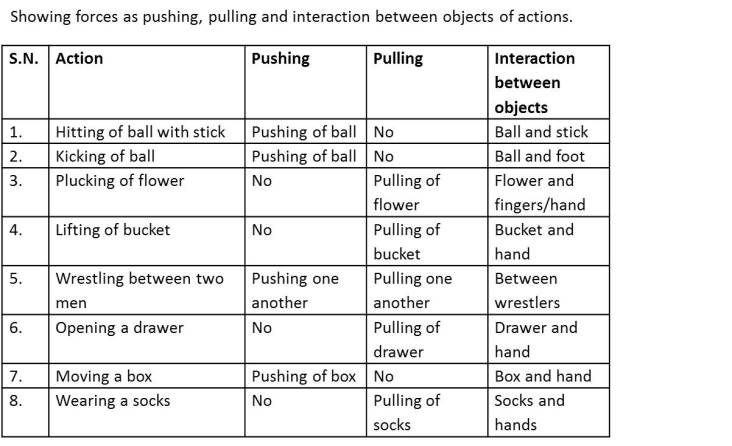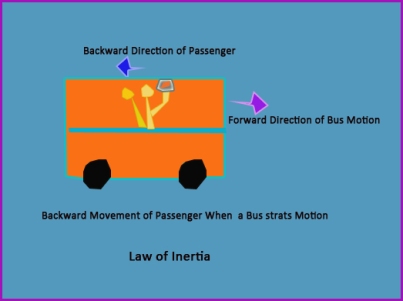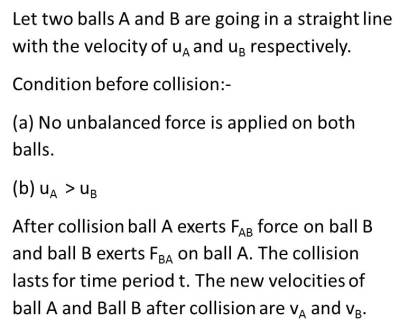(1)Force is a push or pull on an object which arises due to interaction with other objects and can change position, size and shape of the object.

Eg:- Hitting, plucking, lifting kicking etc. are some examples of pulling and pushing.

(2)Characteristics of force
(i) When two or more forces applied in same direction on an object, the net force applied on the object is addition of forces.

Eg:- When two people push a heavy box in same direction box started to move. It happens because of total force applied on the box by two people.
(ii) When two forces applied in opposite direction on an object, the net force applied on the object is subtraction of forces.

Eg:- In a tug war when both teams pull rope:-
(a) rope does not move if force of both team is equal.
or
(b) rope moves towards to that team which applied more fore.
(iii)Force has magnitude and direction. Therefore, it is a vector quantity. If direction and force of change, its effect changes.
Eg:-
If force is applied from the left direction, the object will move to right direction. But if force is applied from right direction, the object will move towards left direction.
(iv)Force can change the state of motion of an object.
Eg:- kicking of a ball can change its motion and direction.
(a) Kick a ball which is at rest. After applying force (kick) ball started to move in the direction of kick.
(b) Kick a ball while it is moving. It started moving fast in the direction of force (kick).
(c) Catch a ball will bring it at rest in the hand of player.
(v) Force can change the shape of an object.
Eg:-
(a)A dough can change its shape (chapati) while applied force (rolling the dough) on it.

(b)Pressing inflated balloon between palms gets bursts and lost its shape.
(3)Types of force
(i) Contact Force
Contact force is a force which acts at a point of contact of two objects.
Eg:-
(a) Lifting a bag – Contact force applied at the point where hand touches bag.
(b) Kicking a ball – Contact force applied at the point where leg touches ball.
(c) Pulling a rope – Contact force applied at the point where hand touches rope.
(d)Pushing a box- Contact force applied at the point where hand touches box.
Types of contact forces
Muscular Force
Muscular force is a force which results due to the action of muscles.
Eg:-
(a) Lifting school bag – Hand muscles are used to lift school bag.
(b) Pulling cart of grains by ox- Different muscles of ox are used in pulling cart of grain.
(c) Pushing a car- Different muscles of body are used in pushing a car.

In all above examples, muscle power or muscular force is used to perform a task.
Frictional force
Frictional force is a force produced by contact of two or more surfaces to resist the motion of the body in opposite direction of motion.
Eg:-
(a) A bicycle comes to rest after stopping paddling- Frictional force between wheel and earth decreases the motion of bicycle and gradually it comes to rest.
(b)A ball comes to rest after it starts rolling on the ground- Frictional force between ball and earth decreases the motion of ball and gradually it comes to rest.
(c)Walking on the floor – Frictional force between feet and earth decreases the motion of feet and it helps us to move on it.
Tension force
The force which is transmitted through the string, rope and wire by the force applied at the opposite end of string or wire ,is known as tension force.
Eg:-
(a)War of tug:- Both end of rope is pulled by two persons or team.
(b)Hanging stone at the end of a rope:- Stone applied force through rope.
(ii)Non – Contact Force:- Non contact force is the force which acts on an objects without being in contact with the object.
(a)The Earth pulls every object towards itself.
(b)Magnet pulls iron objects without being in contact with the objects.
Types of non- contact Force
Gravitational force
The force which pulls every objects with mass towards each other, is known as gravitational force. It only attracts or pulls objects.
F = GMm/r2
Where F = Gravitational Force
G= Gravitational constant
M =Mass of the one of those objects which attracts each other
m = mass is the other object which attracts each other.
r = radius of the two objects
Magnetic Force
A magnetic force is the force which is exerted by the magnets when they bring near to other magnets or iron objects.
Eg:-
(a) Like poles of two magnets repel or push each other.

(b) Unlike poles of the two magnets attract or pull each other.

(c) Magnets pull iron objects towards them without being in contact of objects.

(iii) Electrostatic Force
The force exerted by a charged body on another charged or uncharged body is known as electrostatic force.
Eg:-
(a)Plastic bags attracts towards our clothing:- When we unwrap our packets plastic bags gets charged and attracts towards our clothing.

(b) A straw rubbed with paper attracts other straw which is not rubbed with paper.
(4)Equilibrium of objects
Equilibrium occurs when resultant force acting on an object is zero.
Balanced forces are forces which do not allow an object to move from its position of rest.

Eg:-
A box lying on the floor will remain in position of rest. Forces applied on the box is equal and in opposite direction.
Unbalanced forces are those forces which allow an object to move from its position of rest.

Eg:-
A box lying on the floor will start move when applied force is not equal. The box will move when applied force is bigger than friction force. The box will move in direction of force.
(5)Inertia is a natural tendency of an object to resist a change in state of motion or rest. The mass of the object is measure of inertia.
Eg:-
(a) Pile coins of carom game on the board and strike on the pile with force. The coin at the bottom will move forward and rest of the pile fall down due to inertia. The rest of the pile wants to keep its position of rest and fall down.
(b)We fall down backward when a car or bus starts moving. When car start motion our feet also move forward with car or bus. But our upper body wants to keep its rest position. Therefore, we fall backward due to inertia.

(6)Newton’s Laws of Motion
(i) Newton’s first law of motion
An object remains in state of rest or state of uniform motion until a force is applied on the object to change its state.
The first law of motion is also called as law of inertia.
Eg:-
(a)The dust particles of a blanket are fall off when blanket is jerked because dust particles want to remain in their position of rest.
(b)The fruits of tree fall down if tree is shaken forcibly because fruits wants to remain in their position f rest.
(7)The rate at which object changes its velocity is known as acceleration. It is a vector quantity.
It is detonated by a.
a = velocity/time
Its unit = m/s2
When an object changes its velocity by equal amount in every one second is called constant acceleration.
(8)Momentum is the product of mass and velocity of that object.
If mass of the object is m kg and moving with velocity v m/s.
Momentum of the object p = mv
Unit of momentum = kg m/s
Eg:-
(a) Momentum of the truck is very large even at low velocity because mass of the truck is very large.
(b)A small bullet can hurt a human because of its large momentum [Large velocity]
We know that force can change velocity of an object. Even velocity of a heavy object can be change with application of continuous force. Continuous application of force may take time but can change velocity.
Therefore, force is necessary to change the momentum depends on the time rate at which momentum is changed.
Eg:- Sometimes car with low or dead battery can start with application of unbalanced force [push] by people. It may possible that they have to attempt two or three times. It means they take time but continuous application of unbalanced force results in acceleration of car.
(9) Newton’s second law of motion
The rate of the momentum of an object is directly proportional to the applied unbalanced force in the direction of the force.
Mathematical formulation of the second law of motion
Let an object of mass m is moving with initial velocity u. It is uniformly accelerating with a velocity v in time t, an unbalanced force f is applied on it throughout the time t.

Eg:-
(a) When a player in cricket catches a ball pulls his hands backwards. It increases time, at the result of this velocity of ball decreases to zero. Acceleration of ball also reduced. Therefore, player saves himself from injury.
If player does not pull his hands backward, velocity of ball will reduced to zero at once. As the result of it rate of change of momentum will be high which apply strong force which can cause injury to player.


(10) Newton’s third law of motion
When an object exerts a force on other object the equal force is exerted by other object in opposite direction.
But, the acceleration produces by both objects differ because of difference in magnitude of their mass.
The alternative statement of this law,ie,to every action there is always an equal and opposite reaction.
Eg:-
(a)When we collide with other person, both feel hurt. It happens because of equal and opposite force exerted by both persons.
(b)When a bullet is fire from a gun, we feel a jerk in shoulder. It happens because gun exerts an equal and opposite action on the bullet and bullet also exerts an equal and opposite reaction on the gun. But acceleration of the bullet is greater than the acceleration of the gun because of less magnitude of the bullet in comparison of the gun.
Conservation of Momentum:-
When there is no unbalanced force the momentum is conserved.
In other words, sum of momentum of two objects is equal to the sum of momentum after collision.




Helping Topics
